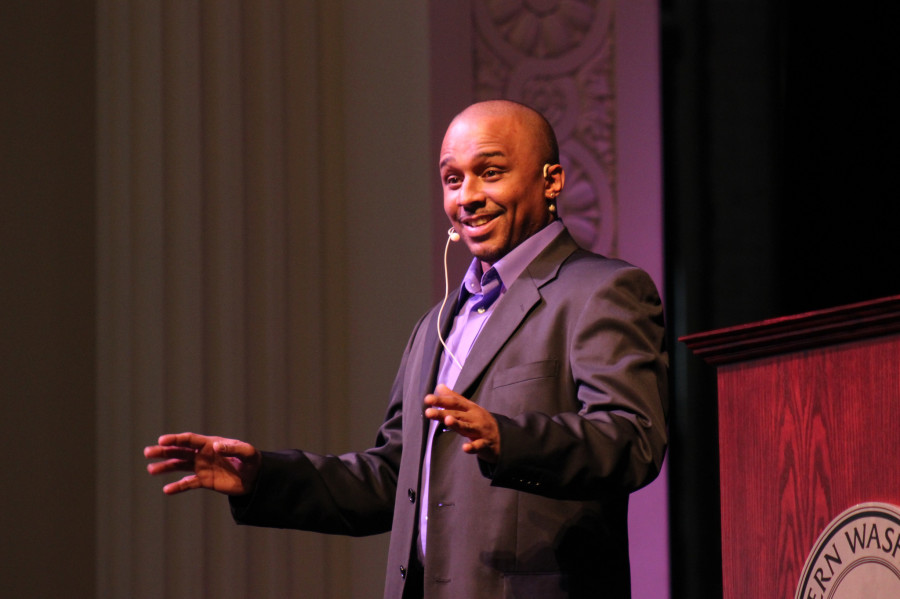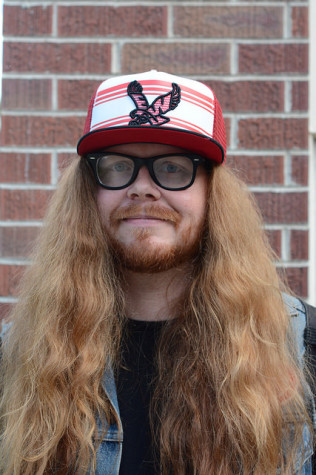Speaker recounts brush with death row, court system
February 20, 2014
At age 19, Gerald Hankerson was sitting on death row at the Washington State Penitentiary in Walla Walla, Wash.
Last week, Student Activities, Involvement and Leadership, in collaboration with the Africana Studies Education Department, invited Hankerson, now age 44, to speak at Eastern in celebration of Black History Month.
In 2009, Hankerson became the first man in Washington state history to be released from prison after being sentenced to death. Just under five years after he was granted clemency, Hankerson became the president of the NAACP Alaska, Oregon and Washington and advocates for injustice as a part of his career.
Dr. Scott Finnie of the Africana Education department introduced him to thunderous applause.
“What Mr. Hankerson brings to us is a real life experience,” Finnie said. “Rather than just a theory or a discussion about social justice.”
When he was a teenager, Gerald Hankerson moved to Seattle from Georgia to make a new life for himself. The life he found was not the one he expected.
He made the move to reconnect with his mother, after spending his childhood without her. Meeting her for the first time was not the happy reunion he had expected, but he decided to stick it out in Washington.
One year later, just as he was set to graduate high school, life got bad for Hankerson. What started as some underage kids attempting to buy beer ended with a man being killed.
An altercation arose when Hankerson and two other teens thought a man was trying to steal their money.
One of the teens, Alvin Mitchell, stabbed the man, 27-year-old Nai Vang Saeturn, to death.
Mitchell told police that he and Hankerson had planned to rob Saeturn, and that Hankerson held Saeturn down while he stabbed him.
Hankerson said he was charged and convicted as an accessory to aggravated first-degree murder, resulting in a de facto death sentence.
It was later found that what Mitchell said was untrue. At least two other witnesses who helped implicate Hankerson later came forward to say their confessions were coerced.
“I was 18 years old,” Hankerson said. “I got convicted of a crime that I kept screaming that I didn’t commit, and nobody would listen to me.”
He said, at the time, Seattle was looking to make an example of somebody to show that the city was not going to tolerate people coming in and causing trouble.
He was their example.
Convicted at 18, on death row by 19, he celebrated his 21st birthday in solitary confinement. He sat in a room with a light that never turned off, with his thoughts anchored on what his life had become.
After three lonely years, he was moved into the general population. He said this is when he started to notice something.
Week after week, Hankerson watched new prisoners come in. Every Wednesday, he said he would notice new faces. Brown faces. Black faces.
“That’s when I woke up,” he said. “Maybe it’s not a coincidence that my life ended up this way. Maybe there is something wrong with the system.”
Dr. Latoya Brackett, Eastern’s Africana Coordinator, said the inequalities of the prison industrial complex is an important issue right now, and stories like Hankerson’s, help to bring injustice and the inequalities in the death sentence to light.
“When you put someone to death, you can’t take it back,” Brackett said. “This happens to so many young men, especially black men.”
Hankerson’s frustration with the prison system was boiling. After 10 years in prison for a crime he did not commit, he decided to do something about it.
He created an organization within the prison called the Black Prisoners Caucus, whose main purpose was to discuss the flaws of the prison system with people of the community.
He said his actions were viewed as a threat, and he was moved around the prison system.
Over the next few years, he tried to have his case re-examined at every level of the court system and failed every time, up to his 22nd year of incarceration.
In his 23rd year of incarceration, he applied for clemency. He said there was a huge groundswell of support in the community that advocated for his release. His case was brought to Gov. Christine Gregoire. After a brief consideration, he was denied clemency.
The community response to her decision was massive. There were a lot of people who wanted Hankerson to be set free. Constant lobbying from his supporters and a unanimous recommendation from the state clemency board persuaded Gregoire to reverse her decision.
On April 9, 2009, which happened to be Easter weekend, Hankerson was free for the first time since he was 18 years old.
“I understand what freedom truly means now,” Hankerson said. “I’m eternally grateful, and absolutely blessed.”
Since his release, Hankerson has been busy. Aside from his work with the NAACP, he is a board member of The Defender’s Association, serves on the state’s advisory board of the Office of Public Defense and is a member of Seattle’s Race & Social Justice Initiative Roundtable.
Jackie Vaughn, the leadership adviser for student clubs and organizations with SAIL at EWU, said she met Hankerson last summer through Washington Community Action Network where they are both members.
When someone asked her if she had heard Hankerson’s story, she did not know what they meant.
“I was super blown away,” Vaughn said. “He doesn’t just go around telling his story or even what his position is in the NAACP.
“He’s just a really humble person. But he does know his story is powerful and serves a purpose to educate others.”
Since November, Vaughn has been working with SAIL and the Africana Education Department to bring Hankerson to speak at Eastern.
Not only did Hankerson’s visit to EWU coincide with Black History month, but also with Washington Gov. Jay Inslee’s decision to place a moratorium on the death penalty in the state.
The day before he spoke at Eastern, Hankerson said he responded to Washington Gov. Jay Inslee’s decision. He said he applauded Inslee for making this powerful, courageous move.
According to Hankerson, The NAACP is adamantly opposed to the death penalty and is actively working to have it abolished. He said the major flaw in the death penalty is reflected in his story. In some cases, people on death row have proven their innocence.
Even though he was granted clemency, which means he was forgiven for the crime, and his death sentence has been cancelled, Hankerson still has not been exonerated of the crime, which means the state still believes he is guilty. Hankerson said he takes full responsibility for his action, and his freedom is still based on strict adherence to community custody requirements.
He believes that a change in the structure of the court system is the only way to protect people from being wrongfully convicted, or even put to death.
Hankerson said this is the generation that can actually make those changes, and that education is crucial. If schools are not teaching about the flaws in the system, then students today will not be prepared to make those changes.
“You are that next leader. You are that next decision maker,” Hankerson said to the students of EWU. “My experience is not just for me, it’s for you”








